Why Is Your Tree Losing Bark? Causes and Solutions for Peeling Bark
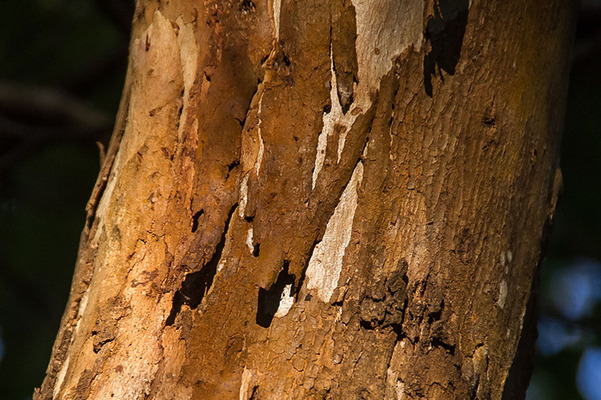
Introduction
Trees add beauty and value to our surroundings, but it can be alarming when their bark starts peeling off. While some tree species naturally shed bark, it's crucial to differentiate between normal shedding and potential issues such as injury or disease. In this comprehensive guide, we'll explore the world of peeling tree bark, covering both natural shedding and the various causes for concern. We'll discuss common culprits behind bark peeling, ranging from weather-related stressors to pests and diseases. More importantly, we'll provide valuable insights and solutions to help your tree thrive and regain its bark-covered beauty.
It is Quite Normal for a Tree to Lose Bark
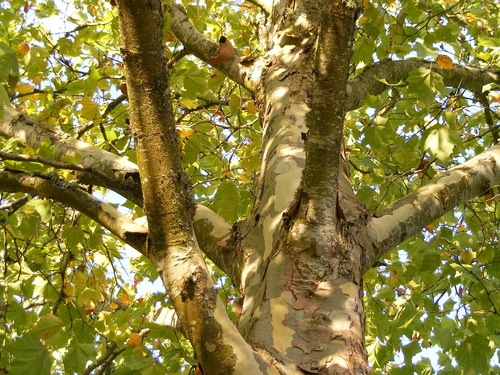
A Lush Tree with Peeling Bark
For some tree species, like silver maple, sycamore, and birch, shedding large chunks of bark is a part of their natural allure. This is because trees develop from the inside out, causing older bark to chip away and making room for new growth.
When bark peels off a tree, the first question to answer is whether it's part of the tree's normal shedding process or if an injury or disease is causing the problem. If you see fresh, healthy bark covering the wood after the old bark peels away, chances are your tree is undergoing a routine shedding process. However, if you uncover bare wood or mats of fungus beneath the peeling bark, it's a clear sign that your tree is experiencing environmental damage or disease.
Signs of a Problem
- Bark falls off after a frost, typically on the tree's south or southwest side, due to sudden temperature drops.
- Bark falls off after an excessive heat spell, leading to bark cracking under stress.
- Bark falls off an unhealthy tree, often accompanied by other signs of stress, such as cankers, sap, or dead twigs and leaves.
Is My Tree Dying if Bark is Falling Off?
Determining whether your tree is in trouble can be complex. If the tree appears healthy overall, there's a good chance it's simply shedding bark as part of its growth process. However, if you notice other concerning signs, it may be a more significant issue. It's essential to take action after an extreme weather event causes bark loss or if other worrisome signs point to larger problems.
Trees provide immense value to our landscapes, so it's concerning when the bark starts peeling off. Loose, peeling bark is a common issue that affects many tree species. While trees can survive bark damage, it leaves them vulnerable to insects and disease. Understanding why bark peels helps you address the problem. With prompt care, trees can recover and continue thriving for years to come.
Common Causes of Peeling Bark
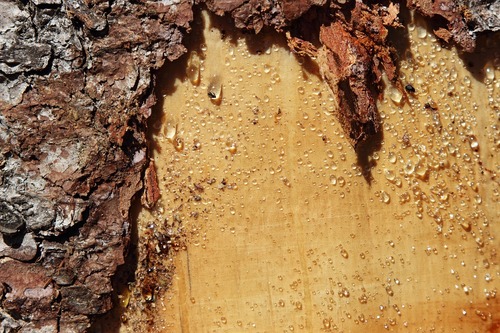
A Bare Spot on a Tree Trunk
There are several typical culprits responsible for bark peeling off trees, including:
Weather Damage
Dramatic temperature changes through the seasons can take a toll on tree bark. In winter, the inner bark and wood shrink, while the outer bark doesn't adjust as quickly, leading to peeling. Wet weather and ample moisture can also loosen bark. When the sun suddenly comes out, the bark dries too rapidly and splits away from the tree.
Sunscald is another issue caused by intense light exposure, especially on the south or west side of young trees. The bark essentially gets sunburned, dies, and peels off. Wrapping tree trunks with light-colored tree guards helps prevent winter and sun damage.
Pests
Insects like bark beetles bore into the inner bark where they feed and lay eggs. This disrupts the tree's nutrient flow right under the outer bark. The damaged areas become weakened and slough off. Keep trees healthy to withstand infestations. At the first sign of insects, apply appropriate pest treatments.
Other critters directly peel away bark with their feeding and clawing habits. Rodents like squirrels and porcupines chew through the bark. Bears rub against trees, scraping off outer bark with their claws. Deer also rub antlers on trees, causing peeling. Wrapping hardware cloth or sheet metal around tree trunks blocks access for these animals.
Disease
Certain fungal diseases infect the bark and cambium layer, cutting off nutrients as they spread and causing bark detachment.
Examples include:
- Armillaria root rot: Also called shoestring root rot, it causes bark to peel at the base of infected trees. It spreads through roots from an existing fungal colony in the soil.
- Cytospora canker: This disease leads to sunken, dead areas on the bark. The affected bark eventually cracks and falls off. It's common on spruce, poplar, and willow trees.
- Anthracnose: Mainly a leaf disease, some species like dogwood anthracnose infect the twigs and bark as well. This causes browning, lesions, and peeling bark.
Raking up and disposing of diseased bark debris is crucial to prevent further contamination. Fungicide sprays when the disease first appears may also help control the infection. With severe cases, the tree may not be salvageable.
Environmental Stress
Any environmental factors that stress the tree can make the bark more susceptible to peeling.
Common triggers include:
- Drought: Without adequate moisture, trees become distressed. The bark dries out, cracks, and falls off. Young and newly planted trees need weekly watering when rainfall is scarce. Add mulch around the base to retain soil moisture.
- Poor Drainage: Excess moisture around the roots deprives them of oxygen. The excess water also encourages fungal diseases that affect the bark. Improve drainage by regrading the area or installing French drains.
- Soil Compaction: Heavy foot traffic near trees compresses the soil, damaging the roots. The tree declines, and the bark peels as a result. Reroute paths away from the tree, and add a layer of mulch around the trunk to protect the soil.
- Mechanical Damage: Bark wounds from lawnmowers, string trimmers, and other maintenance tools provide access for insects and disease. To limit damage, mulch around trees and use tree guards. Handle trees carefully when pruning or performing repairs.
Adequate watering, mulching, improving drainage, and protecting trees from mechanical damage are essential steps to address these issues.
Normal Growth
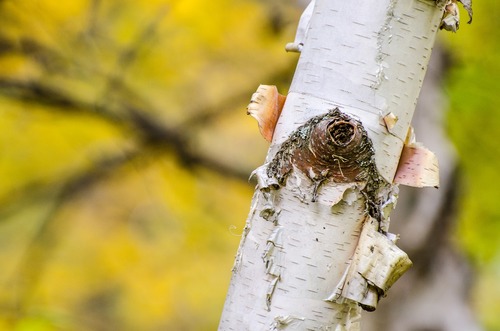
Peeling Bark on a Birch Tree
In some trees, peeling bark is just part of the natural growth process. As the trunk expands, old bark is sloughed off. Many birch, sycamore, and crape myrtle trees exfoliate bark even while healthy. It's normal for the bark at the base of mature pine trees to peel as the tree ages. As long as the exposed wood looks healthy, the peeling isn't a concern.
Solutions for Peeling Tree Bark
To restore damaged trees and prevent further peeling, consider the following solutions:
Improve Growing Conditions
Ensure trees receive adequate water, sunlight, soil drainage, and space to grow. Add compost or nutrient-rich topsoil if the soil quality is poor. Companies like Reencle offer easy solutions such as at-home composters so that you can turn your food waste into odor-free compost for your plants. Lay wood chip mulch around the base to nourish the soil, retain moisture, and protect against damage. Prune branches if the canopy has become overly dense so sunlight can filter through.
Address any underlying issues causing stress and check for signs of disease or pest infestation. Rule out problems like compacted soil and irrigation issues.
Protect the Bark
Pad the trunk with foam insulation or burlap wrapping to protect against sunscald. Wrap hardware cloth around the trunk to keep rodents from gnawing the bark. Use plastic tree guards or fencing to shield the bark from lawnmowers and weed trimmers. For thin-barked trees prone to peeling, apply flexible latex paint directly on the trunk. This mimics the bark's natural moisture and minimizes peeling from rapid temperature changes. White paint reflects sunlight and prevents sunscald damage.
Prune Off Damaged Bark
Use a sharp pruner or saw to carefully remove any loose, cracked, or peeling bark. Pruning exposes the healthy bark underneath and minimizes risk of insects or disease entering the wounds. This is especially important for managing fungal infections. Cut at least six inches beyond the affected area to ensure you prune off infected bark. Disinfect pruning tools with a diluted bleach solution after each cut. Avoid pruning in winter when the tree is dormant.
Fertilize the Tree
Apply a balanced, slow-release fertilizer or compost tea around the root zone in early spring to nourish the tree and promote recovery. Follow product label instructions to ensure proper application rates. Organic mulching, mycorrhizal fungi, and other soil amendments also enrich the soil and support bark healing. Avoid over-fertilizing, which can damage the roots.
Use Topical Treatments
For fungal infections, apply Bordeaux paste over the peeling bark to stop disease spread, as the copper in the mixture inhibits fungus. Prune off any blackened bark and reapply the paste. Swabbing rubbing alcohol over bark beetle entry holes may kill larvae and limit damage. Insecticides like carbaryl (Sevin) can protect against bark beetles. Always follow safety precautions when using chemicals.
Consult an Arborist
A certified arborist can assess the causes of peeling bark and recommend the best restoration methods. In severe cases, the tree may require cabling and bracing for stabilization while the bark heals, or removal may be recommended if the damage is irreversible. Early expert evaluation is crucial when bark damage is first noticed.
Know When to Call a Professional
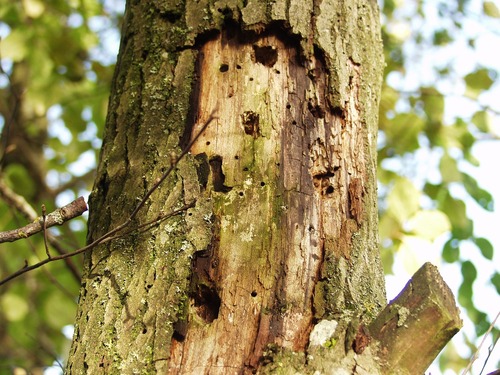
Damaged bark on a Tree Trunk
While some bark peeling is normal, excessive damage can be fatal for trees.
Act promptly and contact a professional arborist if:
- Bark damage covers more than 40 percent of the tree trunk circumference.
- Peeling bark exposes entirely brown or soft inner wood.
- Leaning or collapsing branches indicate overall tree decline.
- Fungal fruiting structures are present, or active beetle larvae emerge from the bark.
- Bark wounds ooze sap or attract insect pests.
- Loose bark is concentrated at the tree base, and roots are likely compromised.
With advanced diagnosis and treatment, arborists can often restore trees exhibiting these severe symptoms. Don't wait until the situation worsens—early intervention is key when your tree starts losing bark.
Conclusion
In the world of trees, bark is more than just skin; it's a vital shield and source of sustenance. While some degree of bark shedding is a natural process, excessive peeling can signal underlying troubles. The causes are diverse, from fickle weather to relentless pests, diseases to environmental stressors. The good news is that peeling bark doesn't necessarily spell doom for your tree.
To rejuvenate your tree's bark-covered beauty, the solutions are as varied as the causes. Ensure optimal growing conditions, protect your tree's bark from sunscald and hungry critters, and don't forget the importance of pruning off damaged bark. With a little care and the right treatments, you can rescue your tree from the brink of despair.
And remember, when the situation becomes too dire or the bark loss too extensive, don't hesitate to seek the advice of a certified arborist. At Arborist Now, our team members possess the expertise to diagnose and prescribe the perfect remedy. Early intervention is key to ensure your trees not only survive but thrive for years to come. So, keep an eye on your trees, protect their bark, and enjoy the beauty they bring to your surroundings.
We may receive affiliate compensation for some of the links below at no cost to you if you decide to make a purchase.
Originally posted on September 15, 2023





